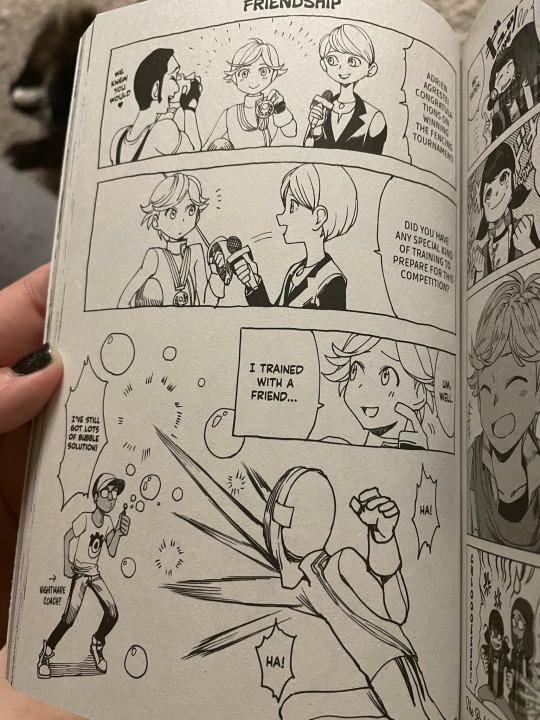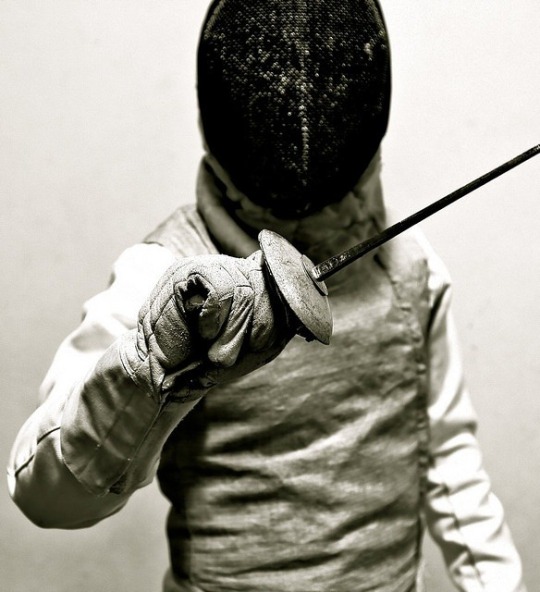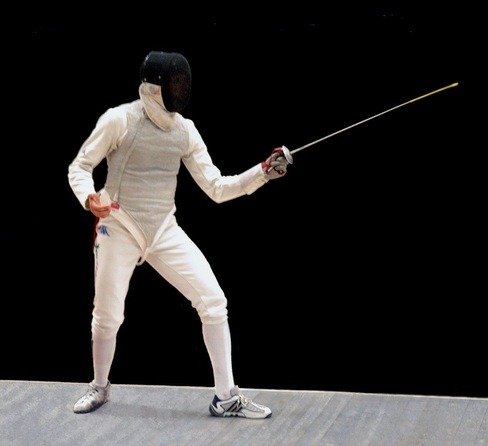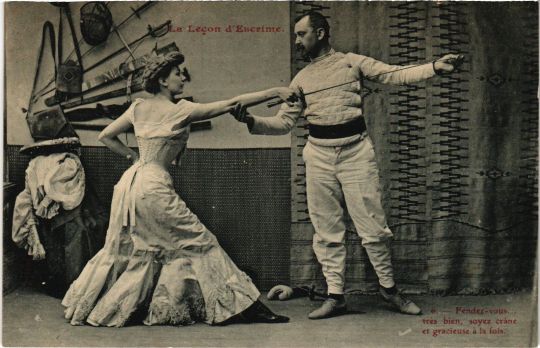#fencing
Text
in HEMA (aka historical european fencing), much of the sport is done with fencing masks on, so identifying your clubmates during sparring or tourneys is just based on gear. you know, what color their jacket and pants are, what patches they have on it, how is their mask painted. If someone borrows someone else's jacket it's legitimately jarring, like having someone with an entirely different body type and way of moving stealing your friend's face.
Once i read about historical fishermen in the north sea and how they each had a specific hat pattern that their buddies would use to identity them while they were bundled up. It was so much part of their identity that they were often buried wearing those hats. The gear is like your name, a visual identifier of YOU when you do not have a face.
anyway, back when I was buying gear i got my pants in ELECTRIC blue. I figured i was gonna get a black or grey jacket. but HEMA gear is kind of expensive because it's all custom- or handmade, so instead of spending $400 on a new jacket I picked up one secondhand for like 20. Except the only jacket that fit me was bright, SCARLET red. And I already had my expensive, new, custom, BLUE pants. I look like a damn rocket pop or like, a mixed Icee. I was like, shit! I should switch my jacket before i become the rocket pop guy!!!
Long story short, not only am I now the rocket pop guy, the color scheme has bled into my entire wardrobe. Every-fucking-thing I own is red and blue. I look like a french revolutionary. I look like a founding father in a school play. I have become a northern fisherman in my stripey hat. Now, even if I DO get a new jacket, I feel like I GOTTA buy it in red, yk? Otherwise they won't recognize me. Maybe I won't recognize me. I'm the rocket pop guy!!!
#Hema#historical fencing#historical european martial arts#Fencing#longsword fencing#western martial arts
17K notes
·
View notes
Text

Riposte
#I thought of this at like 3 AM#then remembered it while I was in shock from falling down a flight of stairs#so you bet I’m gonna blaze this fucker#also#biseuxal#lesbian#gay#for the swords#fencing#swords
23K notes
·
View notes
Text
Me: en gar!
Fencing opponent: it's en garde
Me: *holding an elongated fish* no
#this popped into my head as I was trying to go to sleep#and it was so dumb i had to share it#gar#fish#fishposting#fishblr#marine biology shitpost#fencing
1K notes
·
View notes
Text
Elon Musk challenged me to a fencing competition because I insulted him. We had to use Olympic rules, but he decided to use a sabre instead of a fencing sword. I beat him 10 - 0 and he threw a tantrum and then I woke up.
#dream#text#November 18th 2023#elon musk#fencing#competition#insult#olympic games#olympic#olympics#sabre#sword#queueueueueueueueueueueueueue
733 notes
·
View notes
Text

I love this
#miraculous ladybug#miraculous ladybug manga#manga#fencing#nightmare coach#competition#adrien agreste#nino lahiffe#friendship#op
1K notes
·
View notes
Text

everything you need to know about how the world treats ukrainian in one situation.
olga kharlan defeated russian fencer, after that refused to shake hands with her and that made russian very mad and she was protesting (russians and protesting something is weird to see in one sentence) for 50 minutes to disqualify olga.

olga went through but then was disqualified. so federation took side of a russian (that shouldn't be allowed in the first place but whatever) who lost, but not a ukrainian that fairly won.
but the most disgusting thing that russian sportsman first of all lost a reality check, because why you thought in the first place that ukrainian have to shake your hand, your country literally killing that sportsman people. and secondly her brother is a military person, so she know exactly what is happening right now, what's make it even more disgusting


844 notes
·
View notes
Text
Historical fencing treatise diagrams that look like they're from some kind of wizard manual out of context




The Flower of Battle, Fiore dei Liberi
Trattato di Scientia d'Arme, con vn Dialogo di Filosofia, Camillo Agrippa
Academie de l'Espée, Gérard Thibault d'Anvers
Academie de l'Espée, Gérard Thibault d'Anvers
1K notes
·
View notes
Text

En garde! (Ken Simpson, AD&D adventure Dragon’s Hall, Judges Guild, 1981)
#D&D#Dungeons & Dragons#Ken Simpson#Dragon's Hall#monster#fencing#AD&D#dnd#Judges Guild#Dungeons and Dragons
262 notes
·
View notes
Text
"Fencing offers a ray of hope to young people living in Nairobi's poorest neighbourhoods.
Despite a lack of equipment, the sword fighting sport is growing in popularity in Kenya.
They cut a striking group as they wander through Huruma in their pristine white outfits.
These young people are heading for their favourite hang-out spot: the Tsavora Fencing club at the local community centre.
The street becomes their arena as they parry and riposte in front of passers-by.
This is not just a hobby for them: it's a force for good in their lives.
Fencing has helped carve a path away from crime, drugs and other social pressures.
"I used to be a gangster," says Mburu Wanyoike, who is now a coach for Kenya's National Fencing team.
"I was in crime and crime makes you feel isolated. It actually puts you in a place where you are isolated, making you feel depressed, having stress and I chose fencing as a way for me to escape out of the hood and escape that lifestyle."
His journey from delinquency to fencing coach and senior athlete in Kenya's national team has been transformative.
Inspired by the personal tragedy of the death of two friends, Wanyoike pursued training and education in South Africa, ultimately founding Tsavora Fencing in 2021.
Tsavora Fencing has made significant strides.
The team has produced 15 talented fencers who have earned spots in the national squad, with plans to represent Kenya in the African Olympic Qualifiers in Algeria this year.
However, challenges persist, particularly regarding the affordability of fencing equipment.
"Sometimes it is tough when it comes to competing with well-equipped international countries that are well organized, so what we do is just to move on with enthusiasm and obsession. The fact that we don't have the equipment, the limited ones we have, we use them. We don't complain that we do not have equipment, we just use what we got and put in the obsession and the enthusiasm and the passion combined, that's what we do, we fence," says Wanyoike.
Tsavora Fencing Mtaani, an initiative under Tsavora Fencing, offers mentorship and training in fencing to the youth of these impoverished neighbourhoods, shielding them from the dangers of their environment.
With 45 members, most of whom are students, the team serves as a beacon of hope in the community.
Participants are required to become disciplined and put on integrity.
"Initially I had bad company at home but now that I am in fencing, it has kept me busy and now it is a better option for me because I feel happy doing it," says Jemimah Njeri, a 17-year-old member of Tsavora Fencing.
"I cannot imagine myself without this sport because it has kept me very busy. In my area many girls have become teenage mothers and that is not a wonderful life," adds 16-year-old Allen Grace...
As Tsavora Fencing continues to thrive, fuelled by the determination of its members and the support of the community, it stands as a testament to the transformative power of sport in, even the most challenging environments."
-via Africanews, April 1, 2024
238 notes
·
View notes
Note
What is the difference between fencing and actual sword fighting, exactly? If I were to throw an olympic fencer against a master swordsperson, what would the most likely outcome of such a fight be?
The first and most obvious answer is that only one of these individuals is trained for combat.
The second answer is that only one of them uses (and trains with intent to use) a real weapon.
I’m going to assume this question revolves around an Olympic fencer dueling with a master swordsman with a live weapon and not in accordance with Olympic fencing rules. An Olympic fencer’s best chance at winning is a bout with a modern epee/saber under Olympic fencing rules and it’s also the case where (probably) no one dies or is gravely injured.
Olympic fencing is a sport. As a result of its evolution, it’s pretty much unrecognizable as even a martial form today and, in pursuit of the new requirements for winning, has divested itself of the weapon aspect. While much of the terminology remains the same, the key difference to grasp about Olympic fencers is that they’re not trained to fence around the idea that the sword in their hand is a dangerous weapon (because it isn’t.) In fact, the ultimate goal of winning in their sport (score points) is hindered by that mentality. To the Olympic fencer, it doesn’t matter if they get hit so long as they score first and have right of way when they do. If those at the top of the sport were handed a real historical epee, told to fence, and changed nothing in their approach, the end result would be a double suicide. (Which is ironic because that’s one of the reasons why the epee was restricted historically. When it came to dueling, it was a little too efficient.)
There is no caution here because there doesn’t need to be. Tactics and techniques which will cause a fencer to commit suicide against an opponent with a live blade work exceptionally well once the risk of death is off the table.
This isn’t just restricted to Olympic fencing. If you take any martial art that has transitioned to a sport and put the practitioner up against someone who kills people for a living, even if they are one of the best in their field, they will be at an inherent disadvantage. The requirements for winning according to the sport’s rules are vastly different from the requirements for winning in a life or death situation.
And that’s just the first hurdle.
The next hurdle is the weapon itself.
Duels are specifically between weapons of the same type. This rule is meant to level the playing field and ensure the duel is decided on “skill” rather than weapon advantage. Depending on their point of origin (for the purpose of this question, I’m assuming European) a master swordsman would have been familiar with and likely trained in several different sword styles, depending on era would be a master of their own school or in the employ of a noble house. If you need a comparable profession for a master duelist, think of them like lawyers. Except, the victory was decided by skill with a blade rather than a compelling argument. (We could say that skill with a blade is a compelling argument, but I digress.) One doesn’t get to be a master swordsman until after many years of study with the blade and victories under their belt. Depending on the era of history, the duel requirements of the duel could be anywhere between armored or unarmored, to first blood or to the death, and cover a variety of different swords, each with their own developed styles (and that is styles plural.)
Our Olympic fencer will be fucked by varying degrees depending on the live blade in question but, make no mistake, they’ll be pretty much fucked by any option picked. Running counter to their ubiquitous nature in popular culture, swords are not one size fits all. Outside of common principles there’s almost no training crossover. Every sword handles differently. These variations include length of the blade, length of the hilt, location of the crossguard, the weapon’s weight, the weapon’s weight distribution, the location of its balance point, whether it is primarily used with one hand or two, whether it is primarily a weapon for thrusting (the rapier) or cutting (the saber,) etc. Their grip would be off, and probably wouldn’t be able to hold the sword properly.
The modern version of a fencing “sword” is not equivalent to any of these. Their closest stylistic match up in terms of inherited movement is the 19th century epee, but we’re still miles apart.
Then there’s the mentality issue.
The Olympic fencer hasn’t trained around the idea that death or major injury are accidental. Possible, yes, a risk, yes, but in the same way they are for any other sport. These are surprise, tragic occurrences and not part of regular bouts. For reference, in terms of the dangers of physical contact, a modern fencer faces less risk than a football player. For the master swordsman, the opposite is true. There is no variant of historical dueling which doesn’t risk death in some capacity, whether that’s a confirmed death on the dueling field itself or from an injury or infection later. Those historical circumstances where you see individuals dueling topless is (ironically) for practical reasons and not titillation. Many duelists, victorious or not, died from infection after cloth or other detritus got into their wounds. In this way, our modern Olympic fencer is less prepared than a duelist of average skill, much less a master.
Is the Olympic fencer ready to put their life and body on the line? To risk death, permanent injury, a potential blinding in one eye, in a bout that, at best, involves zero physical protection? I’m not sure. Probably not off the cuff. It requires a different mindset.
Are they ready to inflict damage on another person? Are they ready to kill another person? And even if they’re ready, are they willing to? Are they resolved to? Are they ready to risk their own life in pursuit of it?
The Olympic fencer is on the starting line with these questions.
The Master Swordsman has already answered them.
One of the difficult aspects about writing violence and characters who practice martial disciplines with intent to exercise those skills is internalizing the risks involved and ensuring their a natural part of your character’s mindset and their approach to combat.
Fiction is an illusion. Your narrative’s world is as real as you, the author, choose to make it. Characters are immortal, have infinite stamina, possess skill with every weapon, are unbeatable unless you choose otherwise. Regardless of reality, if you choose to make an Olympic fencer and a Master Swordsman fight exactly the same way with the same skill set, that’s how it is.
I’ve seen plenty of published authors treat swords as universal and modern Olympic fencing like it lends their character any real martial skills. (I mean, beyond excellent conditioning.) You can do it and get away with it if that’s what you want. Personally, I find it less interesting because it cheats the character out of their growth. Also, you don’t need to lean into that approach for “Girls Can Fight” or as a way for a female character to gain combat skills because there were female fencers who trained on the blade.
Ways for the Olympic fencer to win:
Dumb luck.
Yeah. That’s it.
The Master Swordsman should knock the blade out of their hand, take the Olympic fencer under their wing as their apprentice, and wander the world together solving crimes.
10/10.
-Michi
This blog is supported through Patreon. Patrons get access to new posts three days early, and direct access to us through Discord. If you’re already a Patron, thank you. If you’d like to support us, please consider becoming a Patron.
#michi answers#writing reference#writing advice#writing tips#how to fight write#fencing#writing fight scenes
657 notes
·
View notes
Text

#photography#luxury#aesthetic#beautiful#style#lifestyle#sport#fencing#en garde#traditional#sword#sword fighting#gentlemen#monochrome#outfit
150 notes
·
View notes
Text
Sword-fighting tips, from a fencer
I've been fencing for only a few months, but in the time, I've noticed a few things that could help with writing in general.
You don't talk during a bout. This is both a rule and common sense - you get breathless, dancing back and forth, there's no time for a homoerotic back-and-forth. Save that for before, or after.
It's fast. Incredibly fast. Granted, this does depend on which sword you fight, but that's only because of the different rules - good fencers are fast and smooth and it happens so fast it's hard to see the blade move.
Speaking of which - good fencers are smooth! This goes into several areas.
Footwork - incredibly important. You can recover from sloppy swordwork, but footwork is foundational to victory. Fencing footwork looks a lil goofy, but it does genuinely help with balance and speed of movement.

Most of the weight is on the back leg, for launching off with, or, if retreating, the weight shifts to the front leg to launch you backwards.
Swordwork - sloppy swordwork is... alright, but not ideal. For most fights, you want to work on point control - where the tip of your blade is going. I struggle with this myself still, but common practice includes knotting some thick rope, dangling it from a branch or something similar, and letting the rope sway, then trying to hit the knot.
Additionally, any experienced fighter will be incredibly aware of distance - what's the closest they can be without getting hit? How far away can they be but still able to hit? These things determine duels.
How you hold the handle of the sword can actually help your chance of winning quite a lot - one of our instructors says he holds it like you'd hold a bird's body - firm enough so it won't fly away, but gentle enough to not hurt it. This means, that when you go to strike, you can squeeze your hand, and the blade will clear the distance much faster.
Good parries can determine your victory or loss. Often, a parry-riposte can get you the point, or win you the fight - where you get the opponent's blade away from you, then hit them quickly as they're vulnerable.
Depending on your intent in a fight, you may want to dodge instead of parry, though - launch yourself backwards when you expect them to strike to make them miss. In fencing, this would mean (in sabre and foil) that the priority (and ability to get a point) switches to you, whereas in a real match, this could just give you distance if you need to plan a new attack or get away.
Watch fencing matches! If your character is:
Slow and methodical, psyching their opponent out - watch epee
Fast and brutal, hitting hard and relentlessly - watch sabre
Flourished and dignified - watch foil
#sword fighting#sword fighting tips#writing sword fighting#how to write a sword fight#fencing#writerblr#writingblr#writblr#writerblr advice#sword advice#sword fighting advice#hope this helps
243 notes
·
View notes
Text

Opalescent rose Sword
Redbubble
#sword#rapier#fencing#roses#art#artwork#my artwork#doodle#doodles#my art#digital art#dnd#ttrpg#magic weapon#magic weapons#dungeons and dragons#redbubble#opalescent#shiny#dreamerx86#inspo
187 notes
·
View notes
Text

Fencing lesson on a French vintage postcard
#postkaart#lesson#carte postale#fencing#postcard#historic#postkarte#postal#tarjeta#sepia#photo#ansichtskarte#briefkaart#old#vintage#photography#ephemera#french
262 notes
·
View notes
Text
Fencing Club Route is a Go!

Update 2: Chapter 1 Part 3 - Fencing Club Route
Don't feel like playing polo? Join the fencing club instead!
Play the Updated Beta Test
(Since there were bugs reported throughout Chapter 1 & 2, your current saves are probably going to reset to the beginning of each section of the game)
*If you're getting error messages or the fencing club route isn't showing up properly for you (after you refreshed and restarted the game), you'll need to clear your cache. More details found here.*
Additional Word Count (Sans Code): 120,000+
Additional Word Count (With Code): 155,000+
New Total Word Count (Sans Code): 614,000+
New Total Word Count (With Code): 833,000+
Average Playthrough: ~60,000 words
Note: You can view the game code on my site the same way you do on Dashingdon just add /scenes to the end of the URL.
Next Update
Merlin's Guide to Minor Enemies
A bucketload of owed texts & e-mails to the MC
Decisions of great import... just where are you sleeping in that motorhome?
A̴ ̴C̴o̶m̴p̷l̷e̵t̷e̴l̴y̵ ̶N̴o̷r̸m̴a̶l̵ ̵G̴a̴s̸ ̶S̵t̵a̷t̷i̶o̷n̸ ̵S̴t̸o̷p̷
Take part in your first multi-user spell! (Potentially depending on the length of the gas station stop?)
Meet the next Harbinger - RO #4 (Potentially depending on the length of the gas station stop?)
Link to New Polls on the Update (Which don't auto close in a week like the Tumblr ones)
Also...
I'm currently coming down with something (Covid test says not that, so maybe just the flu?) so I'll be taking a bit of a break after this.
More (Fiddly) Info on the Update Behind the Spoiler Cut...
The Update Also Includes...
Calmly letting Merlin into your apartment after escaping the monster-under-the-bed no longer removes the mute flag
Fixed Adrian literally calling the MC as "MC" in the pub
Fixed expresso back to espresso AGAIN *stares at it*
Fixed the phil_status 2 bug AGAIN (Somehow I must've reverted a bunch of bug fixes in Chapter 1)
Fixed bug where MC's name permanently changes to their pseudonym if the player tried to back out of the renaming screen
Fixed the "On second thought, let me try a different fake first name…" option so it only asks the player to change their fake first name (as originally intended)
Fixed some dialogue with Adrian depending upon your clothing choices in the polo club branch
Fixed the Adrian text messaging bug. Again. Hopefully third time is the charm.
Fixed bug where your current job being your dream employment wasn't triggering the positive job attitude flavor text
Fixed bug where the mute flag was being toggled off when interacting with Adrian regarding your fancy outfit before the polo club meeting
Choice where Lucid Dreamer MC talks to Modern Arthur about Merlin's dreamwalking advice is now set to toggle only when the MC speaks to Merlin in the Camelot dream sequence
Fixed bug with the user's input option for Business Casual outfit
User's choice option for Business Casual & Business Suit now toggles pants or skirt variable
Fixed bug with the Cracking text effect in darkmode
All piercings & scars now available in one choice during customization.
Fixed bug (AGAIN!) when Lucky MC fails the luck check to escape the bed monster
Added reactions to Camelot-affiliated names belonging to inanimate objects.
Fixed *set ag2 2 -1 bug in Camelot dream sequence (I wonder how that didn't trigger QuickTest)
A Bit More Info on the Update Mechanics
The decision on which club you join is one of the first questions in Chapter 1, so players will have to restart from pretty early on. However the fencing club flavor text will continue to run throughout the rest of the game (including in the Camelot dream sequence with the Courtyard branch for the Lucid Dreamer MC).
Otherwise this current update does not progress the game further into Chapter 2.
Also Part 2....
We lost power to part of the house (thankfully not including my computer), and while I'm usually the one who deals with the circuit breakers, since I'm currently sick I asked my mother to do it this one time. She turned the power off to the entire house. 🥲 The uninterruptible power source did nothing and now my computer and the microwave are bugging out. I'm just going to lie down now.
#choice of games#hosted games#interactive fiction#if wip#if game#cog#arthuriana#interactive story#oneknightstand#cog wip#if#choicescript#oks-update#one knight stand#if update#fencing
171 notes
·
View notes
Text

Standing Male Nude (1962), William Chadwick
#William Chadwick#male figure#queer art#gay art#art history#gay artists#male nude#gay#queer history#gay illustration#English art#fencing
597 notes
·
View notes